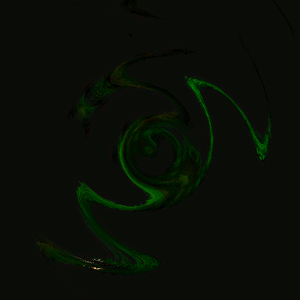The Bikini Explosion
The Hiroshima Explosion, unlike the subsequent Nagasaki explosion, was an air burst high above the surface, so the fallout was insignificant.
But on March 1, 1954, a thermonuclear weapons test at Bikini in the Marshall Islands detonated on the tiny atoll of Rongalap, 150 kilometers away, where the inhabitants likened the explosion to the Sun rising in the West. A few hours later, radioactive ash fell on Rongalap like snow. The average dose received was only about 175 rads, a little less than half the dose needed to kill an average person. Being far from the explosion, not many people died. Of course, the radioactive strontium they ate was concentrated in their bones, and the radioactive iodine was concentrated in their thyroids. Two-thirds of the children and one third of the adults later developed thyroid abnormalities, growth retardation or malignant tumors. In compensation, the Marshall Islanders received expert medical care.
 |
| The global balance of terror holds hostage the citizens of the Earth. Image: © Megan Jorgensen (Elena) |
The yield of the Hiroshima bomb was only thirteen kilotons, the equivalent of thirteen thousand tons of TNT. The Bikini Test yield was fifteen megatons. In a full nuclear exchange, in the paroxysm of thermonuclear war, the equivalent of a million Hiroshima bombs would be dropped all over the world.
At the Hiroshima death rate of some hundred thousand people killed per equivalent thirteen-kiloton weapon, this would be enough to kill a hundred billion people. But there were less than seven billion people on our planet in the early XXI Century. Of course, in such an exchange not everyone would be killed by the blast and the firestorm, the radiation and the fallout – although fallout does last for a longish time: 90 percent of the strontium 90 will decay in 96 years; 90 percent of the cesium 137, in 100 years; 90 percent of the iodine 131 in only a month.
No comments:
Post a Comment
You can leave you comment here. Thank you.